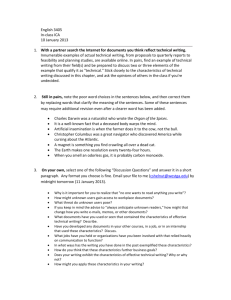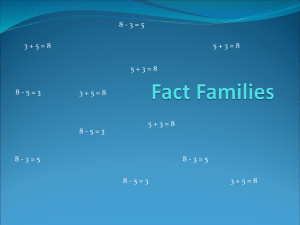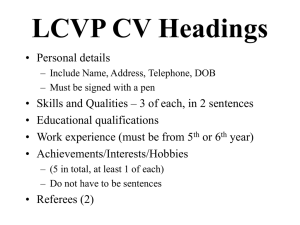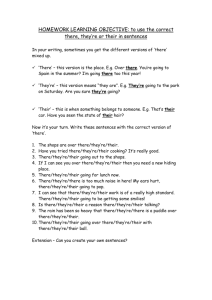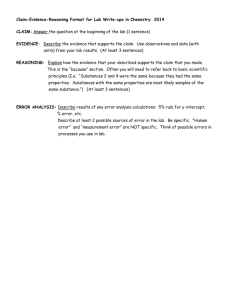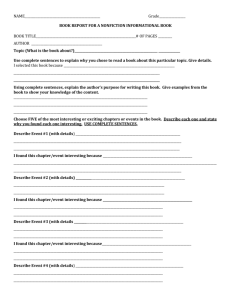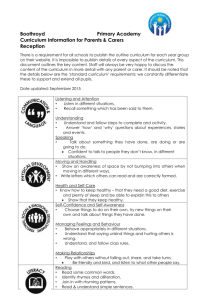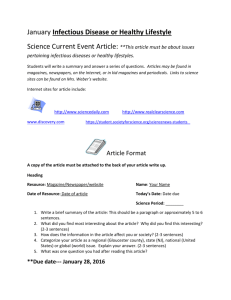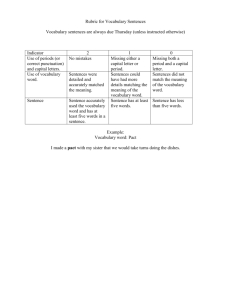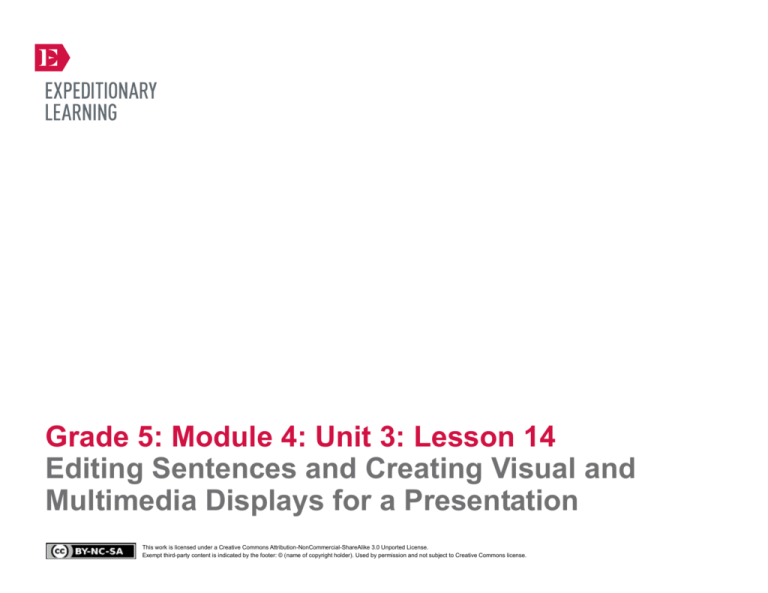
Grade 5: Module 4: Unit 3: Lesson 14
Editing Sentences and Creating Visual and
Multimedia Displays for a Presentation
This work is licensed under a Creative Commons Attribution-NonCommercial-ShareAlike 3.0 Unported License.
Exempt third-party content is indicated by the footer: © (name of copyright holder). Used by permission and not subject to Creative Commons license.
GRADE 5: MODULE 4: UNIT 3: LESSON 14
Editing Sentences and Creating Visual and Multimedia Displays for a
Presentation
Long-Term Targets Addressed (Based on NYSP12 ELA CCLS)
I can use my knowledge of language and its conventions when writing, speaking, reading, or listening. (L.5.3)
a. I can expand, combine, and reduce sentences for meaning, reader/listener interest, and style.
I can report on a topic or text using organized facts and details. (SL.5.4)
I can include multimedia components and visual displays in presentations when appropriate to enhance the development of main ideas or themes. (SL.5.5)
Supporting Learning Targets
Ongoing Assessment
• I can edit my speech draft to address audience interest by expanding, combining, and reducing
sentences for meaning and style.
• Edited draft opinion speech
• Planning for multimedia display
• I can plan a display that includes multimedia components to accompany my speech presentation.
Copyright © 2013 by Expeditionary Learning, New York, NY. All Rights Reserved.
NYS Common Core ELA Curriculum • G5:M4:U3:L14 • June 2014 •
1
GRADE 5: MODULE 4: UNIT 3: LESSON 14
Editing Sentences and Creating Visual and Multimedia Displays for a
Presentation
Agenda
Teaching Notes
1. Opening
• In this lesson, students practice with expanding, combining, and reducing sentences to address clarity
and reader and listener interest. Then they apply their new understandings to edit their draft opinion
speeches for meaning and style.
A. Homework Review and Engaging the Writer (5
minutes)
2. Work Time
A. Expanding, Combining, and Reducing Sentences for
Meaning and Style in an Opinion Speech (15
minutes)
B. Editing Draft Opinion Speeches: Sentences (15
minutes)
C. Planning Visual Displays (20 minutes)
3. Closing and Assessment
A. Debrief and Review Learning Targets (5 minutes)
4. Homework
A. Share your edited speech with someone at home or
read aloud in the mirror. Make additional edits as
needed.
• As in Lesson 13, note the difference between revising and editing. Lesson 12 emphasized revision, when
students participated in peer critique and feedback sessions to revise their draft opinion speeches
(based on the Opinion Speech Criteria developed in Lessons 8–10). In revision, the emphasis is on the
writing process and written work as a whole, considering strengths and weaknesses in all areas for
refinement (including the author’s argument, organization, supporting reasons, evidence, and
mechanics). Remind students of this as necessary.
• Following this, students plan displays to accompany their speech presentations for the final
performance task in Lesson 16. Secure access to any technology or other materials (i.e., poster boards,
markers) for students to create these displays. Also consider collaborating with a media specialist to
support students as they develop their displays.
• Review: Fist to Five in Checking for Understanding Techniques (see Appendix).
• Post: Learning targets.
B. Continue planning your multimedia display based
on the Multimedia Display Criteria
C. Continue reading your independent reading book.
Copyright © 2013 by Expeditionary Learning, New York, NY. All Rights Reserved.
NYS Common Core ELA Curriculum • G5:M4:U3:L14 • June 2014 •
2
GRADE 5: MODULE 4: UNIT 3: LESSON 14
Editing Sentences and Creating Visual and Multimedia Displays for a
Presentation
Lesson Vocabulary
Materials
edit, address, audience, interest,
expanding, combining, reducing,
meaning, style, declarative, plan,
display, multimedia components,
accompany, presentation
• Edited Draft Opinion Speech: How Should Aid Be Prioritized Following a Natural Disaster in a Neighboring Country? (from
Lesson 13; one per student)
• Examples of Expanding, Combining, and Reducing Sentences (one per student and one for display)
• Document camera
• Journals
• Sentence Revision Practice handout (one per student)
• Sentence Revision Practice handout (answers, for teacher reference)
• Editing My Opinion Speech task card (one per student)
• Multimedia Display Criteria (one per student; one to display)
• Display Template 1: Horizontal (one per student; for students who choose this display format)
• Display Template 2: Vertical (one per student; for students who choose this display format)
• Blank paper (one piece per student)
Copyright © 2013 by Expeditionary Learning, New York, NY. All Rights Reserved.
NYS Common Core ELA Curriculum • G5:M4:U3:L14 • June 2014 •
3
GRADE 5: MODULE 4: UNIT 3: LESSON 14
Editing Sentences and Creating Visual and Multimedia Displays for a
Presentation
Meeting Students’ Needs
Opening
A. Homework Review and Engaging the Writer (5 minutes)
• Ask students to collect their Edited Draft Opinion Speech: How Should Aid Be Prioritized Following a Natural
Disaster in a Neighboring Country? and join their regular small groups.
• Ask students to discuss the following prompt with their group:
* “What part of your speech (introduction, body, or conclusion) do you think is strongest and why?”
• Invite members from each group to share their thinking with the class.
• Then, say something like: “Yesterday you focused on using accurate verb tenses and including correlative conjunctions in
your writing to convey your ideas more clearly. Today, you’ll edit your work by expanding, combining, and reducing
sentences to provide clarity or enhance meaning. You will also plan a multimedia display to accompany your speech
presentation. These activities serve to prepare you for the final performance task in which you’ll deliver your opinion speech
to your regular small groups.”
Copyright © 2013 by Expeditionary Learning, New York, NY. All Rights Reserved.
NYS Common Core ELA Curriculum • G5:M4:U3:L14 • June 2014 •
4
GRADE 5: MODULE 4: UNIT 3: LESSON 14
Editing Sentences and Creating Visual and Multimedia Displays for a
Presentation
Work Time
Meeting Students’ Needs
A. Expanding, Combining, and Reducing Sentences for Meaning and Style in an Opinion Speech (15 minutes)
• Direct student attention to the learning targets, and read the first one aloud:
• Consider partnering second
language students with more
proficient English speakers to
complete Expanding, Combining,
and Reducing Sentences and the
Sentence Revision Practice handout
cooperatively.
* “I can edit my speech to address audience interest by expanding, combining, and reducing sentences for meaning and
style.”
• Ask students to think about the following terms with their groups and try to determine their meaning from context: edit,
address, audience, interest, expanding, combining, reducing, meaning, and style.
• Ask for volunteers from each group to share out their group’s definitions:
edit—correct individual sentences for grammar, spelling, or punctuation; sentence level changes; focused on the product
rather than the process
address—attend to; take into consideration
audience—listeners, viewers
interest—attention, curiosity, attentiveness
expanding—developing, increasing, enlarging
combining—joining, merging, linking
reducing—condensing, trimming down
meaning—the essence, main point
style—flair, elegance
• Invite one to two students to restate the first learning target in their own words.
• Then ask students to discuss in groups:
* “Why would a writer edit by expanding, combining, or reducing sentences?”
Copyright © 2013 by Expeditionary Learning, New York, NY. All Rights Reserved.
• Display the three types of editing
practices as well as a brief
explanation of when they might be
used:
• Combine—two or more short,
declarative sentences in a row
• Expand—one short sentence that
needs more detail
• Reduce—a long, run-on sentence
that confuses the reader/listener
• Provide a sentence frame to support
group discussions (“I think the type
of edit this sentence needs is _____
because _____”) .
• Students with difficulties in the
physical act of writing will benefit
from dictating their ideas for edited
sentences to a peer or an aid.
NYS Common Core ELA Curriculum • G5:M4:U3:L14 • June 2014 •
5
GRADE 5: MODULE 4: UNIT 3: LESSON 14
Editing Sentences and Creating Visual and Multimedia Displays for a
Presentation
Meeting Students’ Needs
Work Time (continued)
• Cold call one or two students to share out. Listen for ideas such as: “Sometimes a sentence is so long it confuses the reader or
listener, and they tune out or stop listening; sentences can sometimes be too short; they lack details the reader or listener
needs in order to understand the writer’s or speaker’s ideas; one to two short sentences can be combined into one stronger
sentence, so the focus of the message is not lost or unclear.”
• Say something like: “While a few short, declarative sentences peppered throughout a piece can make a text easier or more
interesting to read or to listen to, sometimes sentences are so short they cause the reader to question the author’s expertise.
To solve this, combine two or three short sentences to create a single sentence that is more informative and concise.”
• Say: “Now we are going to look at some samples from President Obama’s speech in order to practice reducing, combining,
and expanding sentences. You will work with group members on the first few samples. Then you’ll have a chance to
demonstrate your understanding by editing a few more samples independently.”
• Point out that President Obama is often recognized as an excellent speaker, and that many of his sentences are well crafted.
The purpose of this activity is to consider whether edits would make the speech even better, and if so, how students might
use the strategies of expand/combine/reduce to help them as writers.
• Distribute the Examples of Expanding, Combining, and Reducing Sentences to each student, and display a copy
using the document camera. Read the first sample aloud: “In times of great challenge in our country and around the
world, Americans have always come together to lend a hand and to serve others and to do what’s right.”
• Ask students to discuss in their regular small groups and record their idea(s) on a blank page in their journals about:
* “What type of edit might this sentence need: expand, combine, or reduce?”
* “What might the revised sentence be?”
• Cold call one to two students to share out their edited sentence. Listen for students to suggest that although this sentence is
fine as is, it might be easier to listen to if it were reduced: “When there are challenges, Americans have always come together
to provide support and do what’s right.”
• Next, invite students to explain why the reduced version might have greater appeal to the audience or enhances meaning.
Listen for ideas such as: “There were a lot of ‘ands’ in the first version; also, ‘In our country and around the world’ doesn’t
mean anything, since he is saying ‘everywhere.’ So now it says the same thing in a better way.”
Copyright © 2013 by Expeditionary Learning, New York, NY. All Rights Reserved.
NYS Common Core ELA Curriculum • G5:M4:U3:L14 • June 2014 •
6
GRADE 5: MODULE 4: UNIT 3: LESSON 14
Editing Sentences and Creating Visual and Multimedia Displays for a
Presentation
Meeting Students’ Needs
Work Time (continued)
• Students may assert that the sentence is fine as is. Accept this response, but ask how the current sentences appeal to the
audience. If students struggle or are unable to effectively edit the sentence and explain their reasoning, provide an example
of a reduced sentence. Continue to reiterate that reducing, expanding, and combining sentences are tools in a writer’s
toolkit; there is not one correct answer, and authors eventually develop unique styles. The purpose here is to learn and
practice editing techniques.
• Read aloud the second example on the Examples of Expanding, Combining, and Reducing Sentences handout.
• Reiterate that these sentences are effective as is, but this is an opportunity to consider whether Obama might have made a
different choice as a writer. Ask students to discuss the following with group members and record their idea(s) on the same
page in their journals:
* “What type of edit might this sentence need: expand, combine, or reduce?”
* “What might the revised sentence be?”
• Cold call one or two students to share out which edit they chose and their edited sentence. Listen for the likely response of
“combine”: “Every day, we learn more about the horrific suffering of communities that are buried under mountains of
concrete, families forced to sleep in the streets, and the sick and the dying.”
• Next, invite students to explain why the combined version might have greater appeal to the audience or enhances meaning.
Listen for ideas such as: “‘People sleeping in the streets,’ ‘Injured desperate for care,’ and ‘Many feared dead’ are incomplete
sentences. The combined sentence puts the same idea into a smooth sentence using commas to separate items in a list. Not
only is this sentence easier to read and listen to, but it’s also grammatically correct.”
• Explain that authors may intentionally choose to use incomplete sentences for effect. There is not right or wrong “answer.”
Again, the purpose of this activity is to learn and practice editing techniques.
• As with the first example, if students struggle to identify the best type of edit, or effectively edit the sentence and explain
their reasoning, provide an example of a combined sentence.
• Read aloud the final example and repeat the process described above.
• Cold call a few students to share out their idea for an edited sentence. Listen for: “This sentence could be expanded; it’s
difficult to provide the aid people need quickly and efficiently.”
Copyright © 2013 by Expeditionary Learning, New York, NY. All Rights Reserved.
NYS Common Core ELA Curriculum • G5:M4:U3:L14 • June 2014 •
7
GRADE 5: MODULE 4: UNIT 3: LESSON 14
Editing Sentences and Creating Visual and Multimedia Displays for a
Presentation
Meeting Students’ Needs
Work Time (continued)
• As before, if students struggle to identify an edit or provide a possible example, model for them. Continue to reiterate that
Obama’s speech provides strong examples of both short and long sentences, and he made intentional choices as an author.
• Distribute the Sentence Revision Practice handout to each student.
• Say something like: “Now you will have a chance to practice this skill independently by editing a few more sentences from
President Obama’s speech. As you work, consider the fact that for your final performance task, your audience is your
classmates. How could you edit sentences in President Obama’s speech to have greater appeal to students your age?”
• Give students 5 to 6 minutes to complete the practice samples and circulate to support.
• Cold call students to share the edits they made and explain how each edit enhances audience appeal. See the Sentence
Revision Practice handout (answers, for teacher reference).
B. Editing Draft Opinion Speeches: Sentences (15 minutes)
• Remind students of the first learning target.
• Say something like: “As you edit your speeches, consider how to reduce, combine, and expand sentences to enhance meaning
and address audience interest. Remember, your audience is your regular small group members.”
• Distribute the Editing My Opinion Speech task card to each student and display one copy using the document camera.
Read the directions aloud and clarify as needed.
• Give students 12 to 13 minutes to independently edit their speech drafts.
• Circulate to support as needed and use this time to provide focused feedback to individual students regarding their edits.
• Students who are stronger at
auditory processing will benefit
from hearing their speech read
aloud by a peer or aid (or consider
supplying kids with a Phonics
Phone); they’ll hear the subtleties of
sentence variety for the purpose of
reducing, combining, or expanding
sentences for clarity.
• If students finish early, ask them to pair up with another student and quietly read their edited sentences aloud to one
another for feedback regarding how each sentence adds meaning and enhances audience interest. Remind students to be
kind and specific with their critique.
Copyright © 2013 by Expeditionary Learning, New York, NY. All Rights Reserved.
NYS Common Core ELA Curriculum • G5:M4:U3:L14 • June 2014 •
8
GRADE 5: MODULE 4: UNIT 3: LESSON 14
Editing Sentences and Creating Visual and Multimedia Displays for a
Presentation
Work Time (continued)
Meeting Students’ Needs
C. Planning Visual Displays (20 minutes)
• Direct student attention to the posted learning targets and read the second one aloud:
• If technology is not available,
students who struggle with fine
motor skills and the physical act of
writing neatly should be able to
dictate their ideas to a peer or an aid
to help plan/draft their display.
* “I can plan a display that includes multimedia components to accompany my speech presentation.”
• Ask students to think about the following terms with their groups and try to determine their meaning from context: plan,
display, multimedia components, accompany, and presentation.
• Ask for volunteers from each group to share out their group’s definitions:
plan—diagram, sketch, prepare
display—show, present, demonstrate
multimedia components—graphics such as pictures, photos, colors, and text accompany—go together with, complement,
supplement
presentation—presenting something, prepared speech
• Invite one to two students to restate the second learning target in their own words based on their understanding of key
terms.
• Explain to students that speakers often create visual displays to enhance their presentations. These displays are meant to
emphasize key ideas and details the speaker shares during presentations.
• Ask students to recall and discuss in groups what they learned in Unit 2 about how images and text, such as captions, add
meaning to a writer’s ideas.
• Cold call members from each group to share their thinking aloud. Listen for ideas like: “The colors used create a mood; dark
colors suggest fear, sadness, devastation, whereas brighter colors give the impression of joy or happiness; the way images are
arranged and the size of each image serves to emphasize or deemphasize certain ideas and details, draws viewers’ eyes to
certain ideas and details more than others; text such as titles and captions provide clarification about larger ideas and
smaller details.”
Copyright © 2013 by Expeditionary Learning, New York, NY. All Rights Reserved.
NYS Common Core ELA Curriculum • G5:M4:U3:L14 • June 2014 •
9
GRADE 5: MODULE 4: UNIT 3: LESSON 14
Editing Sentences and Creating Visual and Multimedia Displays for a
Presentation
Meeting Students’ Needs
Work Time (continued)
• Tell students they are going to begin planning their multimedia displays; then, distribute the Multimedia Display
Criteria to each student and display one copy using the document camera. Read each of the criteria aloud.
• Tell students they may use Display Template 1: Horizontal, Display Template 2: Vertical, or they may create their
own template. Display each template, and distribute one piece of blank paper to each student.
• Let students know they will have 10 to 15 minutes to plan their presentation displays, and they should refer to the
Multimedia Display Criteria as they work.
• If students finish early, ask them to partner up and give and receive kind and specific feedback about their display plans
based on the criteria provided.
• As time allows, invite students to share their plans whole group.
Closing and Assessment
Meeting Students’ Needs
A. Debrief and Review Learning Targets (5 minutes)
• Focus students’ attention whole group.
• Provide a sentence starter to
support student responses
(“Multimedia displays can enhance
my presentation by _____.”).
• Ask students to turn to a neighbor and discuss the following question:
* “How does a multimedia display enhance your presentation?”
• Remind students they will need their Multimedia Display Criteria to complete the homework assignment.
• Note students who show 3, 2, 1, or a
fist as they may need more support
editing sentences or planning a
presentation display.
Homework
Meeting Students’ Needs
• Share your edited speech with someone at home or read aloud in the mirror. Make additional edits as needed.
• Consider allowing students to take a
Phonics Phone home to practice
their speech and continuing their
edits
• Direct students’ attention to the posted learning targets and read them aloud. As you do, ask students to use the Fist to Five
checking for understanding technique to demonstrate their mastery of each target.
• Continue planning your multimedia display based on the Multimedia Display Criteria.
• Continue reading your independent reading book.
Copyright © 2013 by Expeditionary Learning, New York, NY. All Rights Reserved.
NYS Common Core ELA Curriculum • G5:M4:U3:L14 • June 2014 •
10
Grade 5: Module 4: Unit 2: Lesson 14
Supporting Materials
This work is licensed under a Creative Commons Attribution-NonCommercial-ShareAlike 3.0 Unported License.
Exempt third-party content is indicated by the footer: © (name of copyright holder). Used by permission and not subject to Creative Commons license.
GRADE 5: MODULE 4: UNIT 3: LESSON 14
Examples of Expanding, Combining, and Reducing Sentences
Name:
Date:
Excerpts from the Transcript: Opening Remarks by President Obama
1. “In times of great challenge in our country and around the world, Americans have always come
together to lend a hand and to serve others and to do what’s right.”
* REDUCE the above sentence.
2. “Every day that goes by, we learn more about the horrifying scope of this catastrophe—
destruction and suffering that defies comprehension. Entire communities buried under
mountains of concrete. Families sleeping in the streets. Injured desperate for care. Many
thousands feared dead.”
* COMBINE the above sentences into one.
3. “It will be difficult.”
* EXPAND the above sentence.
Copyright © 2013 by Expeditionary Learning, New York, NY. All Rights Reserved.
NYS Common Core ELA Curriculum • G5:M4:U3:L14 • June 2014 •
12
GRADE 5: MODULE 4: UNIT 3: LESSON 14
Sentence Revision Practice Handout
Name:
Date:
Decide which revision technique (reduce, combine, or expand) you will use to appeal to your audience
and enhance meaning. Then edit the sentences from Transcript: Closing Remarks by President
Obama on the lines below.
1. “Well, these gentlemen are going to do an extraordinary job, but really what they’re going to do
be doing is just tapping into the incredible generosity, the ingenuity, the can-do spirit of the
American people in helping our neighbors in need.”
Circle one: reduce
combine expand
2. “I want to make sure that everybody got that website one more time. Obviously we’re just
standing it up, but it will immediately give people a means to contact our offices—
www.clintonbushhaitifund.org.”
Circle one: reduce
combine expand
Copyright © 2013 by Expeditionary Learning, New York, NY. All Rights Reserved.
NYS Common Core ELA Curriculum • G5:M4:U3:L14 • June 2014 •
13
GRADE 5: MODULE 4: UNIT 3: LESSON 14
Sentence Revision Practice Handout
3. “And I just want to amplify one thing that was said. We were talking in the back. In any
extraordinary catastrophe like this, the first several weeks are just going to involve getting
immediate relief on the ground. And there are going to be some tough days over the next
several days. People are still trying to figure out how to organize themselves. There’s going to
be fear, anxiety, a sense of desperation in some cases.”
Circle one: reduce
combine expand
4. “Thank you, gentlemen.”
Circle one: reduce
combine expand
Copyright © 2013 by Expeditionary Learning, New York, NY. All Rights Reserved.
NYS Common Core ELA Curriculum • G5:M4:U3:L14 • June 2014 •
14
GRADE 5: MODULE 4: UNIT 3: LESSON 14
Sentence Revision Practice Handout
Answers, For Teacher Reference
Name:
Date:
Decide which revision technique (reduce, combine, or expand) you will use to appeal to your audience
and enhance meaning. Then edit the sentences from Transcript: Closing Remarks by President
Obama on the lines below.
1. “Well, these gentlemen are going to do an extraordinary job, but really what they’re going to
do be doing is just tapping into the incredible generosity, the ingenuity, the can-do spirit of
the American people in helping our neighbors in need.”
Circle one: reduce
combine expand
“These gentlemen will do an extraordinary job of tapping into the generosity of the American people
in helping our neighbors in need.”
2. “I want to make sure that everybody got that website one more time. Obviously we’re just
standing it up, but it will immediately give people a means to contact our offices—
www.clintonbushhaitifund.org.”
Circle one: reduce
combine expand
“I want to make sure everyone has the name of the website www.clintonbushhaitifund.org, as it will
give people the means to contact our offices.”
Copyright © 2013 by Expeditionary Learning, New York, NY. All Rights Reserved.
NYS Common Core ELA Curriculum • G5:M4:U3:L14 • June 2014 •
15
GRADE 5: MODULE 4: UNIT 3: LESSON 14
Sentence Revision Practice Handout
Answers, For Teacher Reference
3. “And I just want to amplify one thing that was said. We were talking in the back. In any
extraordinary catastrophe like this, the first several weeks are just going to involve getting
immediate relief on the ground. And there are going to be some tough days over the next
several days. People are still trying to figure out how to organize themselves. There’s going to
be fear, anxiety, a sense of desperation in some cases.”
Circle one: reduce
combine
expand
“When an extraordinary catastrophe like this occurs it is most important to provide immediate
relief so we can become organized and support those who are in desperate need of our help.”
4. “Thank you, gentlemen.”
Circle one: reduce
combine
expand
“Thank you, gentlemen, for your ongoing support of these relief efforts.”
Copyright © 2013 by Expeditionary Learning, New York, NY. All Rights Reserved.
NYS Common Core ELA Curriculum • G5:M4:U3:L14 • June 2014 •
16
GRADE 5: MODULE 4: UNIT 3: LESSON 14
Editing My Opinion Speech Task Card
Name:
Date:
Complete the following:
1. With group members, briefly review and discuss your understanding of how to reduce, combine,
and expand sentences to enhance meaning and address audience interest.
2. Independently read the introduction of your speech.
3. Independently edit the introduction of your speech to reduce, combine, and expand sentences.
4. Repeat Steps 2 and 3 for the body and conclusion paragraphs of your speech.
5. If time allows, partner with another student within or outside your regular group to read aloud the
sentences you changed for the purpose of receiving feedback about your edits.
Copyright © 2013 by Expeditionary Learning, New York, NY. All Rights Reserved.
NYS Common Core ELA Curriculum • G5:M4:U3:L14 • June 2014 •
17
GRADE 5: MODULE 4: UNIT 3: LESSON 14
Multimedia Display Criteria
Name:
Date:
Directions: Read through each of the criteria. Draw a check mark if you have completed this, or a
minus if you have not yet incorporated this criteria.
Criteria
Content
-
completed
not completed
The topic of the speech is stated and
provides a unifying, overarching focus for
the display.
The opinion is stated.
The four types of aid are named AND
described as most important, second most
important, third most important, or least
important.
Visuals that add meaning
Larger visuals draw viewers’ attention to
key ideas.
Pictures, photos, other images
Smaller visuals show important details.
Visuals are arranged to focus viewers’
attention on key ideas and details.
Visuals incorporate colors that set a mood.
Copyright © 2013 by Expeditionary Learning, New York, NY. All Rights Reserved.
NYS Common Core ELA Curriculum • G5:M4:U3:L14 • June 2014 •
18
GRADE 5: MODULE 4: UNIT 3: LESSON 14
Multimedia Display Criteria
Text that adds meaning
The text reiterates or emphasizes the topic,
opinion, and four types aid.
Quotes, captions, exclamations
The text provides clarification about
visuals.
Copyright © 2013 by Expeditionary Learning, New York, NY. All Rights Reserved.
NYS Common Core ELA Curriculum • G5:M4:U3:L14 • June 2014 •
19
GRADE 5: MODULE 4: UNIT 3: LESSON 14
Display Template 1:
Horizontal
Topic
Opinion
Most important
type of aid
<Image(s)>
<Text>
Second most
important type
of aid
Third most
important type
of aid
<Image(s)>
<Image(s)>
<Text>
<Text>
Copyright © 2013 by Expeditionary Learning, New York, NY. All Rights Reserved.
Least important
type of aid
<Image(s)>
<Text>
NYS Common Core ELA Curriculum • G5:M4:U3:L14 • June 2014 •
20
GRADE 5: MODULE 4: UNIT 3: LESSON 14
Display Template 2:
Vertical
Topic
Opinion
Most important type
of aid
Second most
important type
of aid
<Image(s)>
<Text>
<Image(s)>
<Text>
Third most
important type
of aid
Least important
type of aid
<Image(s)>
<Text>
<Image(s)>
<Text>
Copyright © 2013 by Expeditionary Learning, New York, NY. All Rights Reserved.
NYS Common Core ELA Curriculum • G5:M4:U3:L14 • June 2014 •
21


